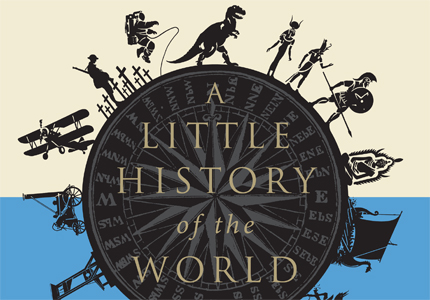World of Letters: Yale’s History with A Little History
 In 1935, with a doctorate in art history and no prospect of a job, the twenty-six-year-old Ernst Gombrich was invited by a publishing acquaintance in Viennato attempt to write a history of the world for younger readers. Amazingly, he completed the task in an intense six weeks, and the book, Eine kurze Weltgeschichte für junge Leser, was published in 1936. A Little History of the World was an immediate success and became an international bestseller, though the Nazi Regime inGermany stopped publication shortly afterwards, deeming the book “too pacifist.”
In 1935, with a doctorate in art history and no prospect of a job, the twenty-six-year-old Ernst Gombrich was invited by a publishing acquaintance in Viennato attempt to write a history of the world for younger readers. Amazingly, he completed the task in an intense six weeks, and the book, Eine kurze Weltgeschichte für junge Leser, was published in 1936. A Little History of the World was an immediate success and became an international bestseller, though the Nazi Regime inGermany stopped publication shortly afterwards, deeming the book “too pacifist.”
In 1985 the original German edition was reissued with a new epilogue bringing the story up to the present, and in the early 1990s, at the end of his long and distinguished life, Gombrich embarked on a new, English version of the book with which he had started. A Little History was his first book, as well as the only one not originally written in English, but despite editions in seventeen other languages, no work had yet been done to bring the volume into English. The book’s worldly scope is still nevertheless European in perspective, and there was doubt whether English-speaking audiences—the British in particular—would be interested in more than English history. Rejecting other offers to produce the work in English, Gombrich was determined to do this translation himself.

E.H. Gombrich (1909 – 2001)
Gombrich had nearly finished with the task of translating and updating when he died, at the age of ninety-two, in 2001. His assistant, Caroline Mustill, faithfully and meticulously completed the work, but as Gombrich’s granddaughter Leonie notes in her new Preface to the illustrated book:
Some changes, of course, could not be made without him: we know that he intended to add chapters about Shakespeare and about the Bill of Frights, and no doubt he would have expanded on, for example, his very brief treatment of the English Civil War and the birth of parliamentary democracy, which carried less weight for the Viennese graduate who wrote the book than for the British citizen he became.

Leonie Gombrich, credit Gerald Janssen
The project came to Yale University Press, renowned for its successful list of history titles, appropriately through the London Office, where the book has continued to grow in our World of Letters since its 2005 publication in English. Writing at publication for the London Times, Lisa Jardine rejoiced: “A Little History of the World is much more than an introduction to history for children. It is a manifesto for freedom and integrity, in which the great art historian offers his personal guide to understanding ourselves and the world in which we live. It is an amazing read: clear, informed, thoughtful and passionate;” meanwhile on our side of the Atlantic, Kristin Hohenadel in the New York Times spoke highly of the book and Gombrich as “a lucid, engaging writer, a brilliant mind made accessible by sparkling prose without a whiff of the academy.”

 In 2008, the bestselling book was released in paperback to even greater success—it is now a staple item in book and museum shops across the US and the UK—but we had only just begun. Fashioned in the same style of forty chapters, A Little Book of Language, written by expert linguist David Crystal, was published in 2010. And 2011 saw the release of philosophy guru Nigel Warburton’s A Little History of Philosophy, for which our most dedicated blog readers have already read Warburton’s post on how he was personally inspired by Gombrich to write his survey of the world’s famous thinkers.
In 2008, the bestselling book was released in paperback to even greater success—it is now a staple item in book and museum shops across the US and the UK—but we had only just begun. Fashioned in the same style of forty chapters, A Little Book of Language, written by expert linguist David Crystal, was published in 2010. And 2011 saw the release of philosophy guru Nigel Warburton’s A Little History of Philosophy, for which our most dedicated blog readers have already read Warburton’s post on how he was personally inspired by Gombrich to write his survey of the world’s famous thinkers.
 Such an important and influential book as A Little History of the World, written by an eminent art historian for children and adults alike, could not be forever without the visual history that accompanies Gombrich’s retelling of human civilization. Already with over 500,000 copies of the book sold, this fall, Yale University Press has proudly published a new, illustrated edition, reflective of its status as a timeless work to be savored and collected, with fine design, cloth binding, and featuring more than 200 color illustrations tied to the text. Parents read chapters nightly to their children, uncovering the story of man from the Stone Age to the atomic bomb, from how people acquired the faculty of speech and learned to make tools to how they waged civil wars and the great global conflicts of the last century, delightfully told by Gombrich’s lively narrative.
Such an important and influential book as A Little History of the World, written by an eminent art historian for children and adults alike, could not be forever without the visual history that accompanies Gombrich’s retelling of human civilization. Already with over 500,000 copies of the book sold, this fall, Yale University Press has proudly published a new, illustrated edition, reflective of its status as a timeless work to be savored and collected, with fine design, cloth binding, and featuring more than 200 color illustrations tied to the text. Parents read chapters nightly to their children, uncovering the story of man from the Stone Age to the atomic bomb, from how people acquired the faculty of speech and learned to make tools to how they waged civil wars and the great global conflicts of the last century, delightfully told by Gombrich’s lively narrative.

E.H. Gombrich with his grandchildren, Carl and Leonie, 1972
It is all the more fitting that A Little History should launch the “World of Letters” column on our blog, as we prepare for stories from Press annals about the books—and the people behind them—that have shaped the legacy of Yale University Press over the last hundred years. A shared history, a little history, is all the space we need to welcome and better acquaint you with our love of books.




